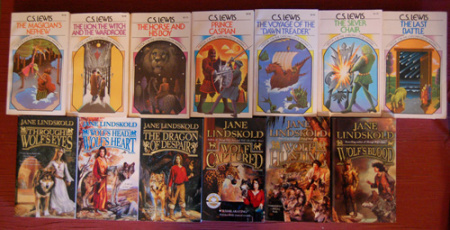Series: Is There Another Word?
This weekend, Jim came to me and asked: “What’s the next book in the Narnia series? I mean, in the order things happen, not the order that’s printed on the books.”

We Call Both Series…
To clarify why he was asking this, the numbers usually printed on C.S. Lewis’s classic Chronicles of Narnia are based on order of publication. They begin with The Lion, the Witch, and the Wardrobe, followed by Prince Caspian, on to The Voyage of the Dawn Treader, and so forth.
If, like Jim, you’re interested in reading the books in the order that events occur, then you want to start with The Magician’s Nephew, progress to The Lion, the Witch, and the Wardrobe, then The Horse and His Boy, and only then on to Prince Caspian, This Voyage of the Dawn Treader, The Silver Chair, and The Last Battle.
(Actually, I’d skip The Last Battle, but that’s just me.)
Anyhow, this lead to a discussion between us as to what constitutes a “series” proper and what doesn’t… Arranged by order of publication, the Chronicles of Narnia are only a “series” is the sense that this is the sequence in which the books were published.
This is very different from, for example, Roger Zelazny’s Chronicles of Amber or Carrie Vaughn’s “Kitty Norville” books or my own “Breaking the Wall” series or “Firekeeper Saga,” to give just a few examples. In these books, not only does the order of publication and the order in which events unfold occur in sequence, but the events are closely related in time and usually revolve around the same protagonist or group of protagonists.
Sometimes, as in David Weber’s “Honorverse,” one series generates another that serves to flesh out or enhance the “main” line. In Weber’s case, two of these are prequels: the “Star Kingdom” YA novels (two of which I wrote with him) and the “Manicore Ascendant” novels written with Timothy Zahn and Thomas Pope. Two other series flesh out material that wouldn’t have fit into the “main line” Honor” novels: “Crown of Slaves” with Eric Flint, and “Saganami Island” written by Weber alone.
In all of these cases, however, the books are tied either by order of events, protagonist, or both.
The Chronicles of Narnia are not alone in being widely viewed as a “series,” even though the only thing that holds the books together is that they occur in a shared setting with some overlapping characters.
Andre Norton’s ”Witch World” novels began tightly focused on just a couple of characters (Simon and Jaelithe), but quickly moved on to their children, then left them behind entirely to explore other portions of the world. When I looked up “Witch World” up on Wikipedia, I found it interesting to note that the listing there did not refer to it as a “series” at all, but as a “project,” with the books within grouped into “cycles” according to location or other elements.
However, most people don’t speak of “Witch World” as a “project,” they call it a “series.” The same is true with Marion Zimmer Bradley’s “Darkover” which not only wasn’t written in order (the first book published could be considered the last) but for which some of the earlier books were later rewritten, so that the same events could be presented in a more detailed fashion or more in line with how the characters had later developed. Talk about confusing!
So, here’s my question… Is there a term for these series that aren’t really series? And what sort do you prefer? Or do both have appeal?





